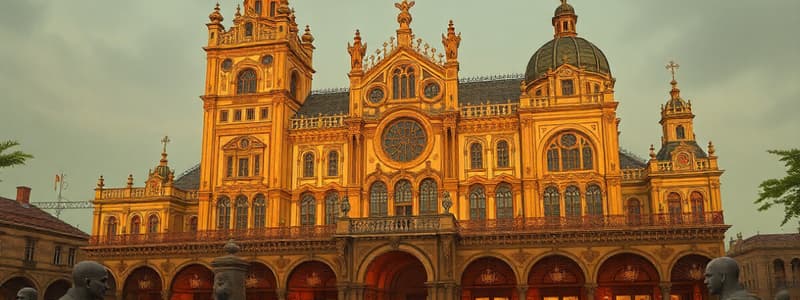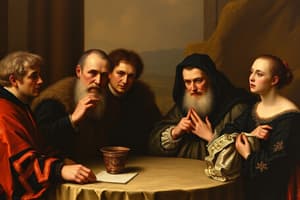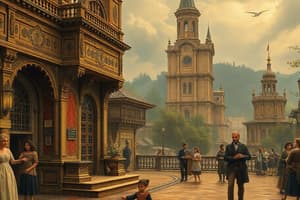Podcast
Questions and Answers
What key event from the 16th century contributed to the intensification of religious disagreements in Europe?
What key event from the 16th century contributed to the intensification of religious disagreements in Europe?
The invention of the printing press in the 16th century was a key factor that led to religious disagreements intensifying in Europe.
Based on the text, why was the city of Venice so prosperous during the Renaissance?
Based on the text, why was the city of Venice so prosperous during the Renaissance?
Venice became a major hub for trade during the Renaissance, amassing wealth through trading ventures, manufacturing, and banking, ultimately making it the richest city in Europe.
What is a key argument presented regarding the book The Prince by Niccolò Machiavelli?
What is a key argument presented regarding the book The Prince by Niccolò Machiavelli?
Some scholars argue that The Prince was a satire. Others argue that Machiavelli was merely describing the political reality of his time.
What is one reason cited for why Europeans became great explorers during the Renaissance?
What is one reason cited for why Europeans became great explorers during the Renaissance?
Explain the connection between the material prosperity of Italy and the cultural aggressiveness during the early Renaissance.
Explain the connection between the material prosperity of Italy and the cultural aggressiveness during the early Renaissance.
Why did the Renaissance start in Italy?
Why did the Renaissance start in Italy?
What does the term Renaissance mean, and how does it represent the time period?
What does the term Renaissance mean, and how does it represent the time period?
Explain humanism and how it relates to the Renaissance.
Explain humanism and how it relates to the Renaissance.
Why might someone think the Renaissance was a time of peace and happiness?
Why might someone think the Renaissance was a time of peace and happiness?
How does the Middle Ages differ from the Renaissance?
How does the Middle Ages differ from the Renaissance?
How does the story of Petrarch show the effects of humanism in the Renaissance?
How does the story of Petrarch show the effects of humanism in the Renaissance?
How did Lorenzo Valla contribute to the Renaissance? Explain your answer.
How did Lorenzo Valla contribute to the Renaissance? Explain your answer.
What specific methods did Lorenzo Valla use to prove that Dionysius the Areopagite was not a first-century author?
What specific methods did Lorenzo Valla use to prove that Dionysius the Areopagite was not a first-century author?
Explain how the invention of the printing press contributed to the spread of humanism in Europe.
Explain how the invention of the printing press contributed to the spread of humanism in Europe.
What economic factors contributed to the rise of literacy and education in Europe during the Renaissance?
What economic factors contributed to the rise of literacy and education in Europe during the Renaissance?
Why was it relatively uncommon for people to own books before the invention of the printing press?
Why was it relatively uncommon for people to own books before the invention of the printing press?
Describe the key factors that led to the printing press being invented in Europe rather than in China, where movable-type had already been developed.
Describe the key factors that led to the printing press being invented in Europe rather than in China, where movable-type had already been developed.
Explain the connection between the increased availability of printed books and the boom in school construction during the European Renaissance.
Explain the connection between the increased availability of printed books and the boom in school construction during the European Renaissance.
Why did early Renaissance humanism flourish in urban centers like Florence, rather than primarily in rural areas?
Why did early Renaissance humanism flourish in urban centers like Florence, rather than primarily in rural areas?
Identify the prominent Florentine family that became known for its patronage of the arts and scholarship during the Renaissance.
Identify the prominent Florentine family that became known for its patronage of the arts and scholarship during the Renaissance.
What was the core mission of the Platonic Academy established in Florence during the Renaissance?
What was the core mission of the Platonic Academy established in Florence during the Renaissance?
How did the move to embrace Plato's philosophy over Aristotle's during the Renaissance signify a shift away from medieval thinking?
How did the move to embrace Plato's philosophy over Aristotle's during the Renaissance signify a shift away from medieval thinking?
Flashcards
Renaissance
Renaissance
A cultural revival in Europe from the 14th to the 17th century, marked by renewed interest in classical art, literature, and humanism.
Humanism
Humanism
An intellectual movement during the Renaissance emphasizing the study of classical texts and the value of the individual human experience.
Petrarch
Petrarch
An Italian poet and scholar known as the father of Humanism who emphasized the value of ancient literature and his epic letters.
Lorenzo Valla
Lorenzo Valla
Signup and view all the flashcards
Donation of Constantine
Donation of Constantine
Signup and view all the flashcards
Italian City-States
Italian City-States
Signup and view all the flashcards
Middle Ages
Middle Ages
Signup and view all the flashcards
Jerome
Jerome
Signup and view all the flashcards
Protestant Reformation
Protestant Reformation
Signup and view all the flashcards
Martin Luther
Martin Luther
Signup and view all the flashcards
30 Years War
30 Years War
Signup and view all the flashcards
Machiavelli
Machiavelli
Signup and view all the flashcards
Printing Press
Printing Press
Signup and view all the flashcards
Johannes Gutenberg
Johannes Gutenberg
Signup and view all the flashcards
Cosimo de Medici
Cosimo de Medici
Signup and view all the flashcards
Lorenzo de' Medici
Lorenzo de' Medici
Signup and view all the flashcards
Platonic Academy
Platonic Academy
Signup and view all the flashcards
Erasmus of Rotterdam
Erasmus of Rotterdam
Signup and view all the flashcards
Renaissance vs. Middle Ages
Renaissance vs. Middle Ages
Signup and view all the flashcards
Medici Family
Medici Family
Signup and view all the flashcards
Study Notes
The Renaissance: A Period of Rebirth
- The Renaissance, meaning rebirth in French, was a period of renewed interest in classical art, literature, and philosophy, beginning in Italy in the 14th century and spreading throughout Europe over roughly 300 years.
- Factors contributing to its start in Italy included a thriving political system of city-states, a burgeoning merchant class, a wealthy middle class with access to education, and the preservation of classical models.
- Humanism, a key element of the Renaissance, emphasized the study of human culture and achievements.
Humanism and the Renaissance
- Humanism sought to explore the world without strict adherence to church doctrines, though many humanists remained religious.
- Key figures like Petrarch demonstrated the impact of reviving ancient learning.
- Lorenzo Valla challenged church authority by demonstrating a classical text, the Donation of Constantine, to be a forgery. This exposed underlying issues in church practices.
- Renaissance thinkers highlighted that troubling times can inspire creativity and reevaluation, not just peace and happiness.
The Middle Ages Context
- The Renaissance was a response to the perceived "Dark Ages" of the Middle Ages, characterized by Christian ideals and emphasis on God over humans.
- Church power limited independent thought and creativity in the Middle Ages, suppressing new ideas.
- The rediscovery of classical texts allowed Renaissance individuals to see their culture's progress and growth, contrasting the situation of their time with the "higher" past.
The Printing Press and Literacy
- Johannes Gutenberg's invention of the printing press and movable type in 1450 revolutionized book production, making it cheaper and more accessible.
- This led to a wider spread of knowledge and a surge in literacy.
- Increased education and literacy correlated with the invention of the printing press.
Patronage and Artistic Flourishing
- Wealthy families like the Medicis of Florence played a crucial role in patronizing writers, artists, and scholars, fostering the artistic and literary advancements of the Renaissance.
- Cosimo de' Medici established a public library filled with ancient manuscripts.
Renaissance Scientific Advancements
- Renaissance scientists relied on observation and experimentation rather than superstition and magic.
- Copernicus posited the heliocentric model of the solar system, challenging the geocentric view.
- Galileo's use of the telescope confirmed Copernicus's theory but led to conflict with the Church.
- Newton's laws of motion and gravity provided a mathematical framework for understanding the universe.
Artistic Innovation
- Donatello's bronze David was a significant artistic innovation.
- Oil painting techniques perfected by Jan van Eyck were central to Renaissance art styles.
- High Renaissance artists, notably Leonardo da Vinci and Michelangelo, dominated the scene, characterized by mathematical harmony and balance in their artwork.
Musical and Literary Achievements
- Renaissance music, with its complex polyphonic compositions, and the invention of new instruments, marked a departure from the music of the Middle Ages.
- Palestrina, a composer noted for his church music, and other Renaissance composers, expanded the world of musical expression.
- Writers like Dante Alighieri, Petrarch, Boccaccio, and Chaucer, and Rabelais, and Cervantes, experimented with vernacular languages, contributing significantly to Renaissance literature.
- Shakespeare demonstrated Italian influences, not just in his settings but in characters and plot lines.
Political and Economic Developments
- Machiavelli, a Florentine diplomat, explored political realities in his writings, especially The Prince.
- Renaissance trade expanded, contributing to the increased prosperity, urbanization, and the formation of trading alliances (e.g., the Hanseatic League).
- Banking also developed significantly.
The End of the Era
- The Protestant Reformation signaled the end of the exclusively Christian worldview.
- Religious persecution intensified alongside religious disagreements, particularly after the invention of the printing press.
- Inquisitions were instituted by Catholics and Protestants alike, causing brutal persecution.
- The period of the Renaissance marked the beginning of exploration and colonization.
Studying That Suits You
Use AI to generate personalized quizzes and flashcards to suit your learning preferences.




